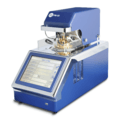Flash point facts for kids
In chemistry, the flash point of a volatile material is the lowest temperature at which its vapors ignite if given an ignition source.
The flash point is sometimes confused with the autoignition temperature, the temperature that causes spontaneous ignition. The fire point is the lowest temperature at which the vapors keep burning after the ignition source is removed. It is higher than the flash point, because at the flash point more vapor may not be produced fast enough to sustain combustion. Neither flash point nor fire point depends directly on the ignition source temperature, but ignition source temperature is far higher than either the flash or fire point.
Contents
Fuels
The flash point is a descriptive characteristic that is used to distinguish between flammable fuels, such as petrol (also known as gasoline), and combustible fuels, such as diesel.
It is also used to characterize the fire hazards of fuels. Fuels which have a flash point less than 37.8 °C (100.0 °F) are called flammable, whereas fuels having a flash point above that temperature are called combustible.
Measurement
Several national and international committees and organizations decide how everyone should measure the flash point. The three main groups that decide this standard for measurement are the CEN / ISO Joint Working Group on Flash Point (JWG-FP), ASTM D02.8B Flammability Section, and the Energy Institute's TMS SC-B-4 Flammability Panel.
The standard for testing the temperature of the flash point tells the equipment, units of measure, the steps to follow, and the precision of the test method.
Images for kids
See also
 In Spanish: Punto de inflamabilidad para niños
In Spanish: Punto de inflamabilidad para niños



